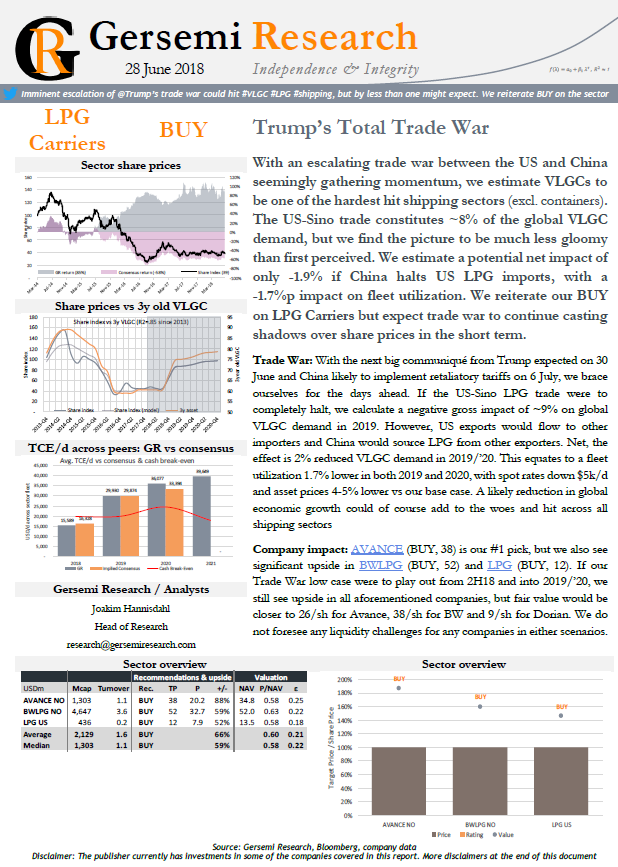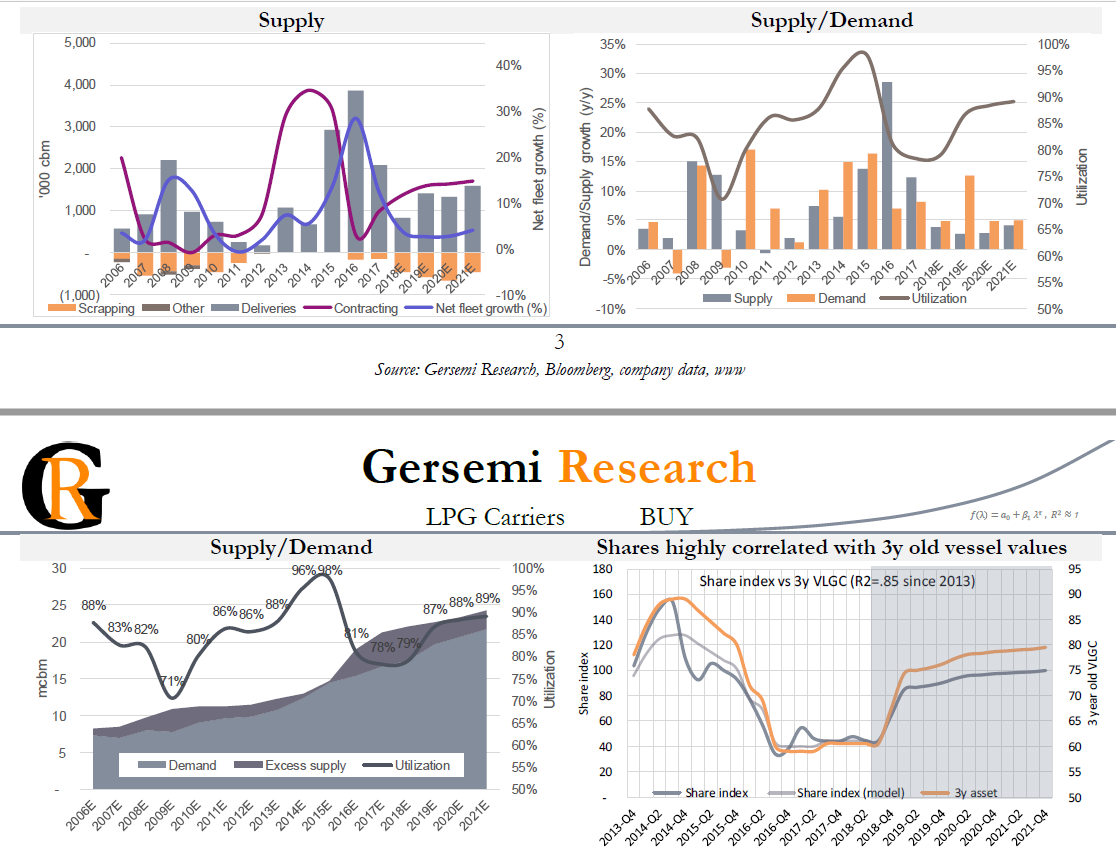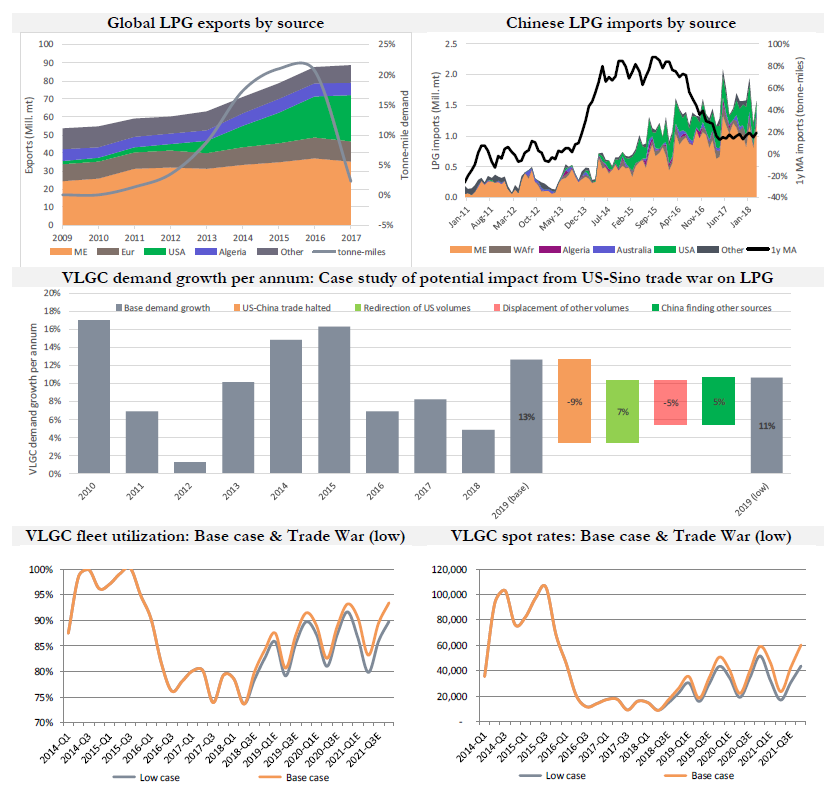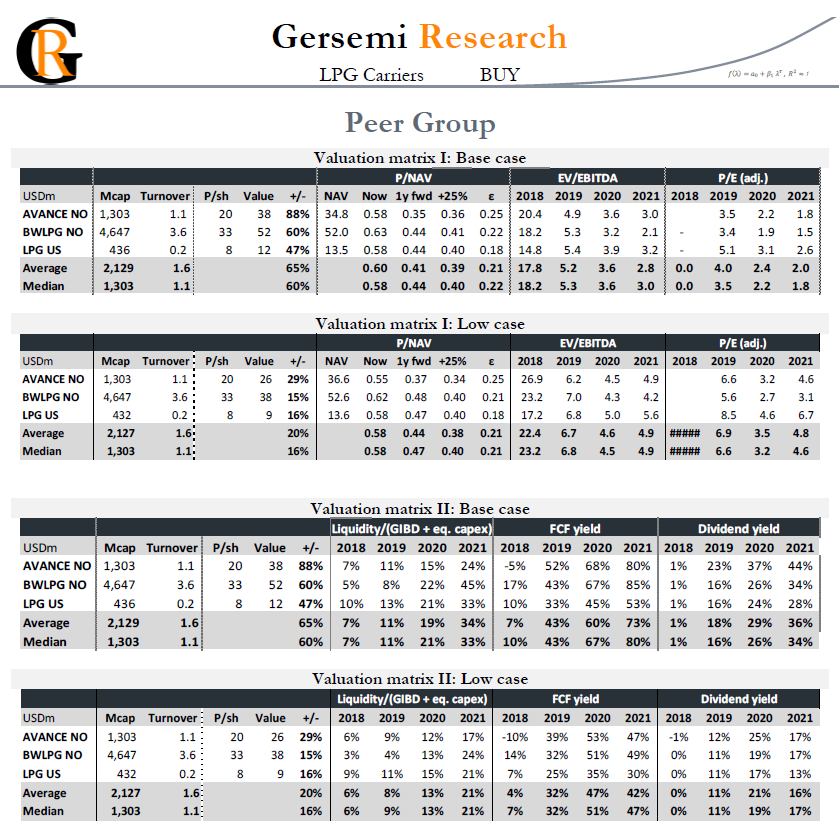With an escalating trade war between the US and China seemingly gathering momentum, we estimate VLGCs to be one of the hardest hit shipping sectors (excl. containers). The US-Sino trade constitutes ~8% of the global VLGC demand, but we find the picture to be much less gloomy than first perceived. We estimate a potential net impact of only -1.9% if China halts US LPG imports, with a -1.7%p impact on fleet utilization. We reiterate our BUY on LPG Carriers but expect trade war to continue casting shadows over share prices in the short term.
Trade War: With the next big communiqué from Trump expected on 30 June and China likely to implement retaliatory tariffs on 6 July, we brace ourselves for the days ahead. If the US-Sino LPG trade were to completely halt, we calculate a negative gross impact of ~9% on global VLGC demand in 2019. However, US exports would flow to other importers and China would source LPG from other exporters. Net, the effect is 2% reduced VLGC demand in 2019/’20. This equates to a fleet utilization 1.7% lower in both 2019 and 2020, with spot rates down $5k/d and asset prices 4-5% lower vs our base case. A likely reduction in global economic growth could of course add to the woes and hit across all shipping sectors
Company impact: AVANCE (BUY, 38) is our #1 pick, but we also see significant upside in BWLPG (BUY, 52) and LPG (BUY, 12). If our Trade War low case were to play out from 2H18 and into 2019/’20, we still see upside in all aforementioned companies, but fair value would be closer to 26/sh for Avance, 38/sh for BW and 9/sh for Dorian. We do not foresee any liquidity challenges for any companies in either scenarios.
Please download the full 27-page report for supporting tables and graphs

VLGC Fundamentals
We are optimistic toward improving markets in both the short and long term due to the low net supply growth, high demand growth and on-going seasonality/support from high energy prices.
Although we have reduced our forecast for 2018, mainly as US exports YTD have missed the mark, we do see the current regional LPG pricing differential between the US and the Far East finally absorbing vessels on long voyages which in turn is edging spot rates ever higher. The recent reopening of the Mariner East 1 pipeline should lead to more trapped US LPG volumes flowing to the coastal export facilities, and support US exports which YTD is -9% y/y but MTD is +28%.
We forecast VLGC fleet utilization of 79% in 2018 and 87% in 2019, representing average VLGC spot rates of $17k/d and $35k/d, respectively. The positive effect of a weaker 2018 than expected is that contracting of newbuildings have grinded to a halt, with only one VLGC contracted since January. For the full year we reduce our contracting forecast from 22 VLGCs to 16, and together with an increased scrapping forecast for 2019/20 due to adjusted IMO 2020 considerations, we expect net supply growth of 3-4% to remain below demand growth at 5-13% per annum over the same period.
The positive effect of a weaker 2018 than expected is that contracting of newbuildings have grinded to a halt, with only one VLGC contracted since January. For the full year we reduce our contracting forecast from 22 VLGCs to 16, and together with an increased scrapping forecast for 2019/20 due to adjusted IMO 2020 considerations, we expect net supply growth of 3-4% to remain below demand growth at 5-13% per annum over the same period.
Share prices tends to look 12-18 months ahead, and thus the scene could be set for significant share price appreciation for VLGC shipping companies ahead in concert with rising asset prices. We see a potential 95% average upside to shares in the sector over the next year.

Trade War
After the US-Sino trade war first rattled the markets in early February, it soon seemed that all the commotion was Trump’s tactic to bring a strong hand to the negotiation table. That illusion has now shattered as one tariff after another is unilaterally levied on both friends and foes.
The next key date is 30 June, when Trump is scheduled to announce restrictions on Chinese investments in the US and new controls on the exports of technology products to China. Then on 6 July, Chinese tariffs on US goods are expected to be implemented. This could in turn trigger an aggressive response from the US with a new round of tit-for-tat trade restrictions.
US-Sino LPG trade in depth
Over the past few years, US LPG exports have become a significant part of global seaborne LPG trade, with around 19% of Chinese LPG imports sourced from the US in 2017. We expect US exports to increase significantly going forward, concurrent with increased Chinese demand. As this is arguably the most tonne-mile intensive VLGC trade, a Chinese trade embargo on US LPG as retaliation to aggressive US trade policy could at first glance have a disastrous impact on VLGC utilization, earnings and share prices.
However, the picture is more nuanced than it first might appear. We calculate an immediate 9% negative effect on VLGC demand in 2019 if China ceased all together importing US LPG. Assuming US exports would still be lifted, we see 50% going to other Far Eastern states and the remainder going short to Europe or Latin America based on recent trading patterns. The average sailing distance would be reduced by some 25% (from 10,083NM to 7,546NM) but this mitigates the effect of zero US cargoes going to China by adding 7% to VLGC demand. Then, we assume that the newfound destinations for US LPG replaces other export sources, removing 5% VLGC demand. This again is offset by China having to replace its lost US cargoes from other sources, adding 5% VLGC demand to the equation. The net effect is our base case VLGC demand growth of 12.6% for 2019 being reduced to our low case at 10.7%.

Correlation vs the Broad Market Index
We view a trade war and/or general weakening of the global GDP growth as our main concerns at present when investing in shipping and oil services.
As a general rule, listed VLGC companies have close to an insignificant statistical correlation with the relevant broad share price indexes such as S&P 500 and OSEBX. Although reassuring if shit hits the fan, we still expect large sell-offs to impact VLGC shares indifferent of the fundamentals as investors scramble to adjust their risk profile. Also, in a scenario with reduced global economic growth regardless of the cause, shipping in general will be affected indirectly from lower seaborne trade volumes, which in turn could impact demand for oil and impact our oil service coverage.



